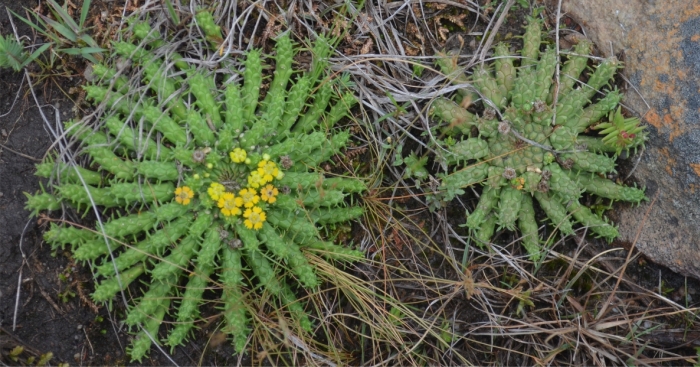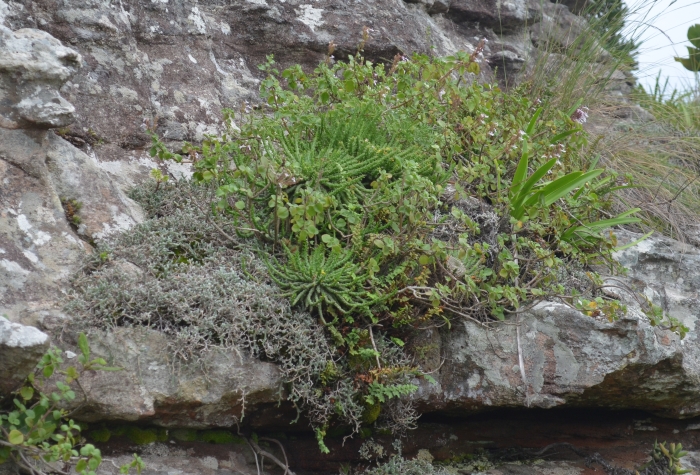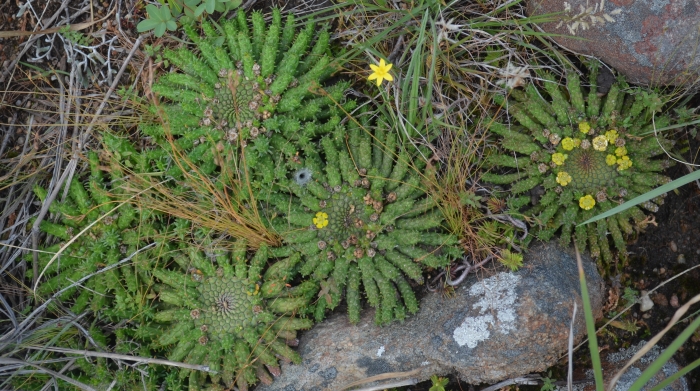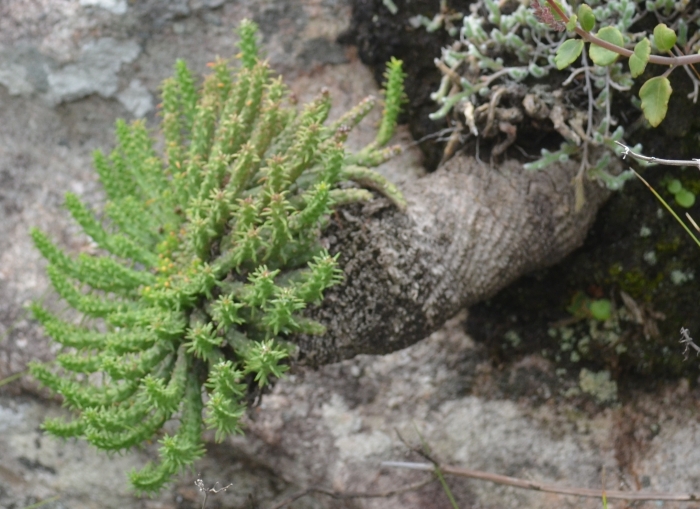Euphorbia flanaganii
Euphorbia flanaganii N.E.Br.
Family: Euphorbiaceae
Common names: Transkei medusa’s head, Flanagan’s euphorbia (Eng.); vingerpol (Afr.); nhlehle, isihlehle (Zul.)
Introduction
A dwarf succulent plant with snake-like branches growing flat on the ground, only known from the coastal areas of the Eastern Cape and south coast of KwaZulu-Natal.

Description
Description
Euphorbia flanaganii is a dwarf succulent plant with a swollen underground stem. Cylindric branches grow, flat on the ground, spreading horizontally, up to 400 mm in diameter. Leaves are very small, up to 10 mm long and 1 mm broad, with a linear to acute shape.

Flowers are cyathia, clustered on the central branches; each cyathium with a single, 4 mm long flower per flower stalk. Bracts are arranged to form a whorl surrounding the ovary, 6 mm in diameter. Petals, sepals and stamens are attached at the base of the ovary (a superior ovary) and the ovary is attached directly to the flower stalk. Flowers are usually formed on the central part of the plant, on the apex of the stem, sometimes on the inner young branches.

Conservation Status
Status
Populations of Euphorbia flanaganii are decreasing because of habitat loss and harvesting of plants for medicinal uses. The species is, therefore, assessed as Vulnerable (VU) in the Red List of South African plants.

Distribution and habitat
Distribution description
This species is distributed mainly on the Indian Ocean Coastal Belt Biome, from the Eastern Cape to the south coast of KwaZulu-Natal. It grows in Transkei coastal belt (Port St Johns to Kei River) and parts of Pondoland-Ugu Sandstone coastal sourveld (Port Shepstone, Port St Johns). Its habitat receives rain in summer, with light rain in winter. Average temperature of 32ºC in summer and there is no frost.

Derivation of name and historical aspects
History
The genus Euphorbia was named after Euphorbus, who was a medical doctor to King Juba of Mauritania, in the first century. The name Euphorbia is from a Greek word, euphorbe, that means ‘good pasture’, eu means ‘well’ and phorbe means ‘pasture’. The specific epithet flanaganii is given in honour of Henry George Flanagan (1861–1919) who was a plant collector, botanist and farmer, and he was the first collector of this species. There are also other plants that were named in his honour such as Raphionacme flanaganii, Scolopia flanaganii, Greyia flanaganii and Selago flanaganii.
The family Euphorbiaceae has over 200 genera, such as Croton, Dalechampia, Erythrococca, Clutia, Acalypha, to name a few and over 6 000 species. Euphorbia is found in all continents and countries, except Antartica. In South Africa we have 32 genera and approximately 188 known species.
The botanist N.E. Brown in his work on Euphorbia in 1915 recognized a number of species that are now regarded as a single variable species: E. flanaganii. These former species, now synonyms of E. flanaganii, inlude E. discreta, E. ernestii, E. franksiae, E. gatbergensis, E. passa and E. woodii.

Ecology
Ecology
Flowers of Euphorbia flanaganii attract butterflies, bees and other insects. Fertilized flowers form capsules, when the fruits are ripe, the capsules dry, and split open to release the seeds. Seeds are dispersed in late summer to autumn and are banked in the soil during the dry winter months. This species flowers in summer (November–January) to autumn (February–April), and releases the seeds during the flowering period as the earlier flowers get fertilized and capsules ripen while the plant is still flowering. This species is well adapted to dry conditions, because of its succulent underground stem and branches and the plant can resprout after veld fires.

Uses
Use
Euphorbia flanaganii is a commonly used ornamental plant in landscaping and as a container plant. The whole plant is collected for medicinal purposes and sold in traditional ‘muthi’ markets. The latex is used during pregnancy, as a purgative, and is applied to wounds and skin lesions. Many euphorbias are known to be used, such as E. decussata, which is traditionally used as yeast, E. ingens, which is used for building material, and E. virosa, E. subsala and E. cooperi, which are used as poisons for hunting and fishing.

Growing Euphorbia flanaganii
Grow
Euphorbia flanaganii is fast growing and thrives in hot, humid climates and is not resistant to frost. This species grows very well in full-sun positions, in rocky areas such as rock gardens and also as a pot plant and in hanging baskets. Water the plants in summer and keep them dry in winter. Other Euphorbia species that best complement E. flanaganii include, E. ingens, E. triangularis, E. grandidens, E. multifolia, E. bubalina and other small succulent plants, such as species of Aloe, Crassula, Cotyledon, Tylecodon, Cyphostemma, Gasteria, Cheiridopsis, Kalanchoe, Adromischus, Adenium etc.

Plants can easily be propagated sexually (by seeds) and asexually (by division). Coarse river sand is an ideal medium for sowing the seeds and rooting divided suckers. Sow seeds in autumn (from February to April), cover the seeds with a thin layer of sand and keep in a warm, moist area. Divide the suckers in spring (August to October). When propagating from division, it is important to leave the suckers for a day for the milky latex to dry and dust the wounds with fungicide, before placing the cuttings into the medium. Keep the soil moist, not wet, to avoid rotting. Use coarse bark at the bottom of the seedling tray or pot to improve water drainage
References
- Bruyns, P.V. 2012. Nomenclature and typification of southern African species of Euphorbia. Bothalia 42(2): 217–245.
- Hutchings, A., Scott, A.H., Lewis, G. & Cunningham, A.B. 1996. Zulu medicinal plants: an inventory. University of Natal Press, Pietermaritzburg.
- Mucina, L. & Rutherford, M.C. (eds) 2006. The vegetation of South Africa, Lesotho and Swaziland. Strelitzia 19. South African National Biodiversity Institute, Pretoria.
- Van Wyk, B.-E. & Gericke, N. 2000. People's plants. Briza Publications, Pretoria.
- White, A., Dyer, R.A. & Sloane, B.L. 1941. The succulent Euphorbieae (southern Africa). Volume 1 & 2. Abbey Garden Press, California.
- Williams, V.L et al. 2014. Euphorbia flanaganii N.E.Br. National Assessment: Red List of South African pPlants version 2017.1. Accessed on 2019/02/11.
Credits
Ntuthuko Mabuya
Pretoria National Botanical Garden
March 2019
Plant Attributes:
Plant Type: Succulent
SA Distribution: Eastern Cape, KwaZulu-Natal
Soil type: Sandy, Loam
Flowering season: Late Summer, Autumn
PH:
Flower colour: Yellow
Aspect: Full Sun
Gardening skill: Easy
Special Features:
Horticultural zones







Rate this article
Article well written and informative
Rate this plant
Is this an interesting plant?
Login to add your Comment
Back to topNot registered yet? Click here to register.